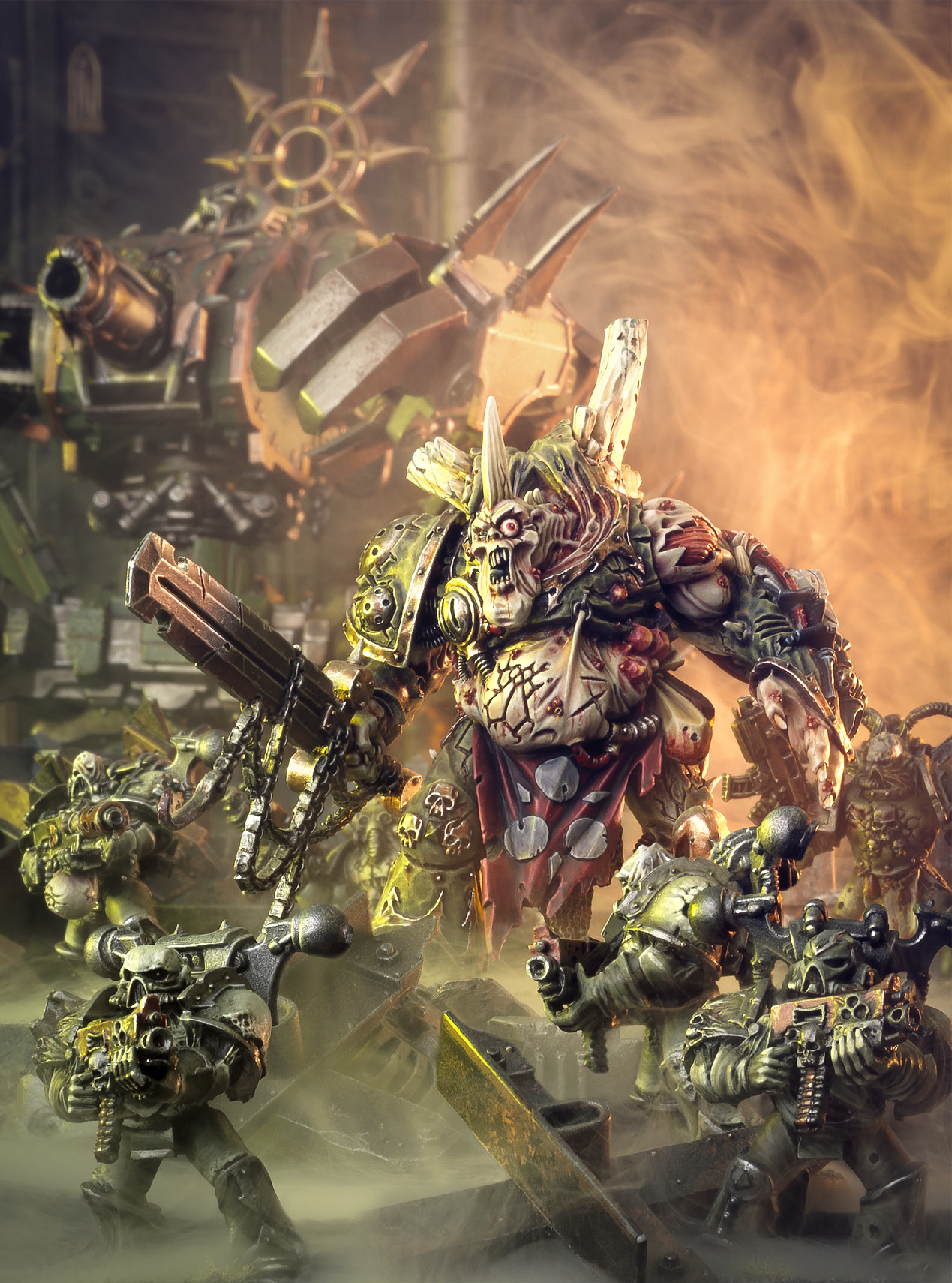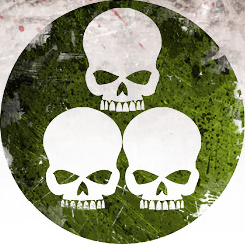
[ Models | Lore | Sources | Inspiration ]
Even before the Horus Heresy, the Death Guard did not manoeuvre fancifully, or concern themselves with confusing their opponents; they picked the best ground upon which to fight, then smashed their foes after they had broken themselves against the Death Guard line. There was no environment which Mortarion, their Primarch, or the Death Guard feared. Thanks to their superhuman ability to resist poison and disease, no toxic smog or corrupted atmosphere deterred their course. What Mortarion and his adepts could not devise means to compensate for, the Death Guard overcame through sheer resilience. The Warmaster Horus above all others recognised the value of the Death Guard; he would often place Mortarion and his Legion in the centre of his battle line, counting on the enemy's inability to oust them so that he could either lever his advance from the rock of Mortarion's immovable position, or use it as the anvil upon which his hammerblow assault would break the foe.
When Horus led his attack on the Emperor, the rebel Death Guard Legion became marooned in the Warp while attempting the long journey to Terra. Days passed while the fleet's Navigators searched for a Warp-tide that would bring them back to the material universe. Meanwhile a mysterious contagion began to spread from ship to ship.
The stinking pestilence bloated the gut, distended the flesh, and turned its victims rotten from the inside. For the Space Marines of the Death Guard there was nothing so terrifying as the Destroyer plague which made their legendary resilience meaningless. These were the warriors who the Imperium had sent to conquer worlds no other man could set foot upon, much less fight on and win. There had been no pestilence, contagion, toxin or pollution potent enough to overcome Mortarion and the Death Guard, until the plague raced through their fleet. It roiled in their guts, warping their once superhuman bodies, transforming them into horrible, pustulent grotesques. They were made corrupt within and sickening to behold without and they grew sicker and sicker, yet could not die, their own constitution becoming their worst enemy. Eventually even Mortarion became infected, and in his delirium he called upon the powers of Chaos to aid the Space Marines. Mortarion's fevered ravings were answered by Nurgle, and he became Nurgle's champion.
The Death Guard, newly dedicated to Nurgle, arrived in time to take part in Horus' attack on Terra and fought in all of the major battles of the campaign. What emerged from the Warp when the Death Guard fleet broke out bore little resemblance to what had entered. The gleaming white and grey armour of Imperial champions was no more, burst and shattered from the horrific bloating of infected bodies, scabbed with boils, putrescence and the filth of corruption. Their weapons and machinery of war were now powered by the sickly sorcery of Chaos, glowing with lambent green luminescence and oozing gangrenous pus. The name Death Guard itself would pass into secondary use, as the walking pestilence-carriers became a terrifying sight across the Imperium. To their victims, to their erstwhile allies, even to themselves, they had become the Plague Marines.
The beliefs of the Death Guard echoed those of their Primarch, and a resolute determination that individuals should be free of oppression and terror became a conviction that individuals were not suited to decide what was just for them. A faith in inner strength, iron will and unshakeable resolution in the face of hardship led to pride, arrogance and an utter contempt for those they deemed inferior. When Nurgle's blessings came to the stranded Death Guard, their pride and arrogance were revealed, and their contempt for weakness turned upon themselves. Their surrender to Nurgle left them with only one seething, burning outlet, stoked white-hot by the depth of their self-loathing: to infect the strong, slay the weak and rot the foundations of everything in their paths until it collapses. Their debasement would no longer seem so shameful, if the pestilence of their Unclean Lord eventually brought everything to ruin.
After Horus' defeat, Mortarion led his Death Guard in a merry dance of destruction over a score of planets, until finally retreating with his Legion into the Eye of Terror - but not in disarray, as many of the other Legions did. Even in damnation, the resilience of the Death Guard remained, and under the direction of their Master they withdrew into the Eye intact, loyalist Space Marines and Imperial Army regiments breaking upon them time and again. There, Mortarion received Nurgle's ultimate reward, and became a full-fledged Daemon Prince, ruling over one of Nurgle's greatest Plague Worlds in the Eye of Terror.
With Mortarion elevated to daemonhood, his hand upon the Legion became more remote and the Death Guard gradually became broken up over space and time into smaller units. Warriors of the Death Guard are most often seen afoot, or at best accompanied by mad, plague-infested Helbrutes. Few of the tanks and transports of the Legion still function, their upkeep and maintenance being no priority to Space Marines dedicated to the Incarnation of Rot and Decay. The Daemon Prince Mortarion remains master of the Death Guard even after their fall, however dispersed they become, orchestrating their movements unseen from his bubonic throne.
Even after the end of the Horus Heresy, the primacy of the foot soldier remained ever the trademark of the Death Guard. Their grim Primarch Mortarion prefers to utilise huge waves of infantry, well equipped and highly trained on an individual level. He demanded that they be able to function and fight in almost any kind of atmosphere, and gave little emphasis on specialised units such as those using jump packs or bikes. The Death Guard were particularly renowned for their success at such high-risk missions as space hulk clearance and the Plague Marines continue that success, using hulks to spread disease, infection and the cult of Nurgle throughout the body of the Imperium. The combat doctrine which served the Death Guard so well in life now suits the damned character of the Plague Marines to perfection.
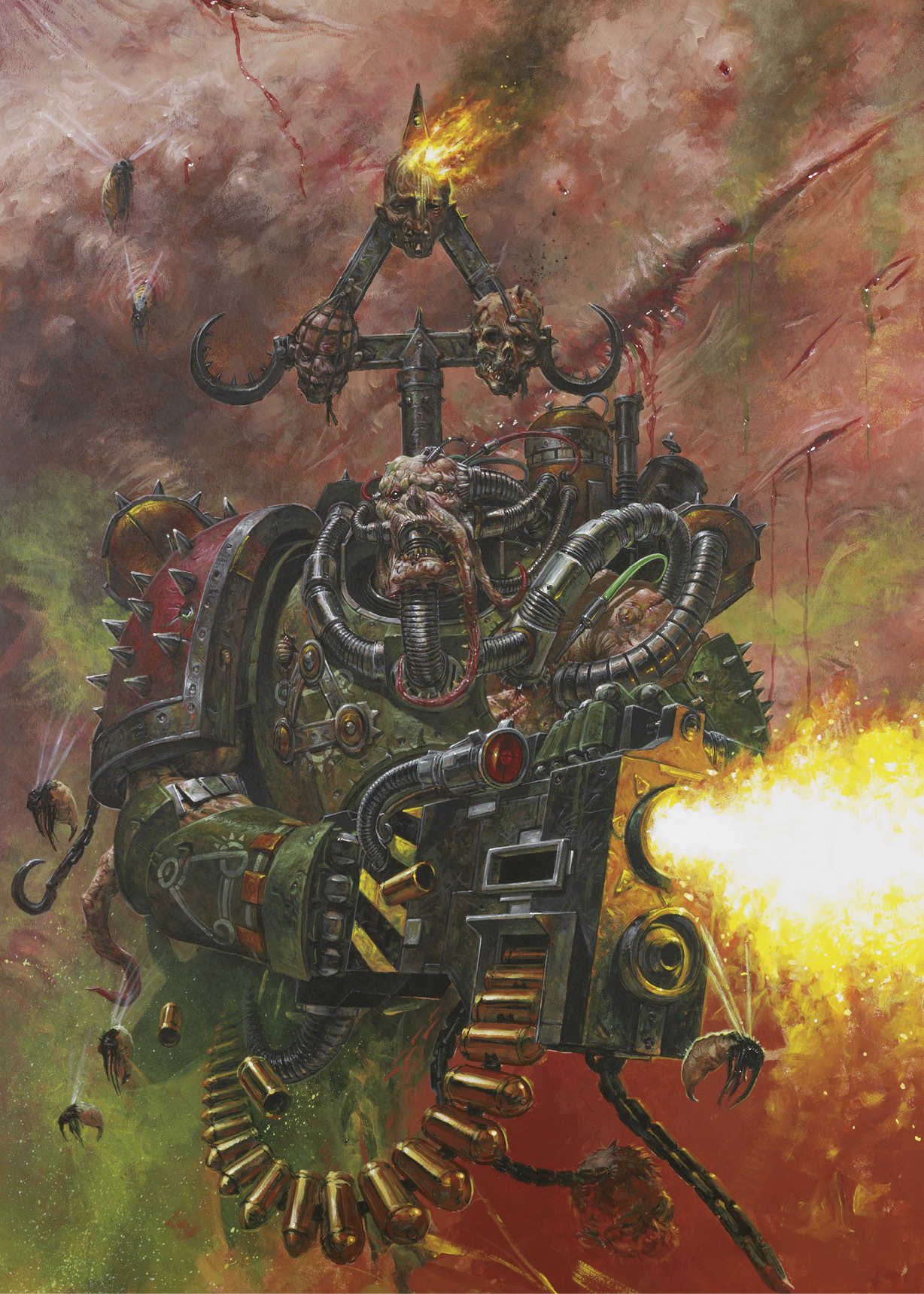
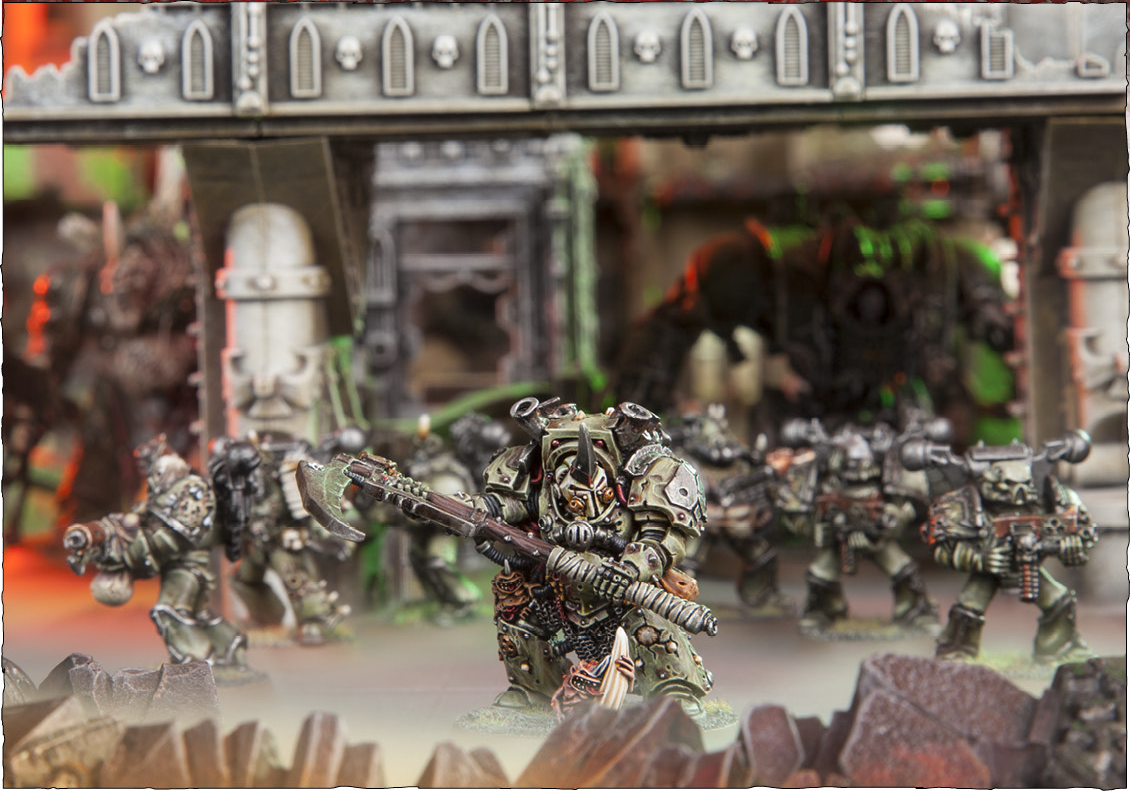
The Death Guard bring the supernatural diseases of Nurgle to the material universe. Tough and relentless, they are impervious to pain.
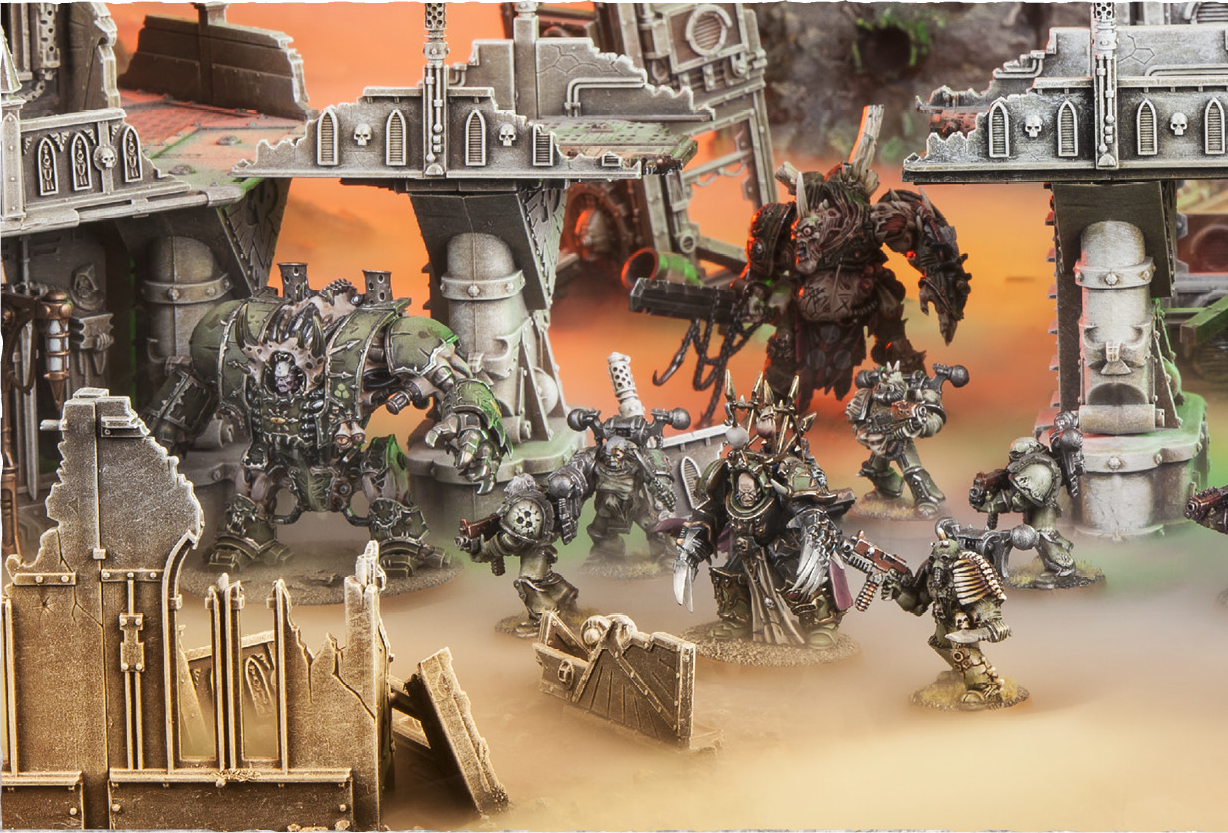
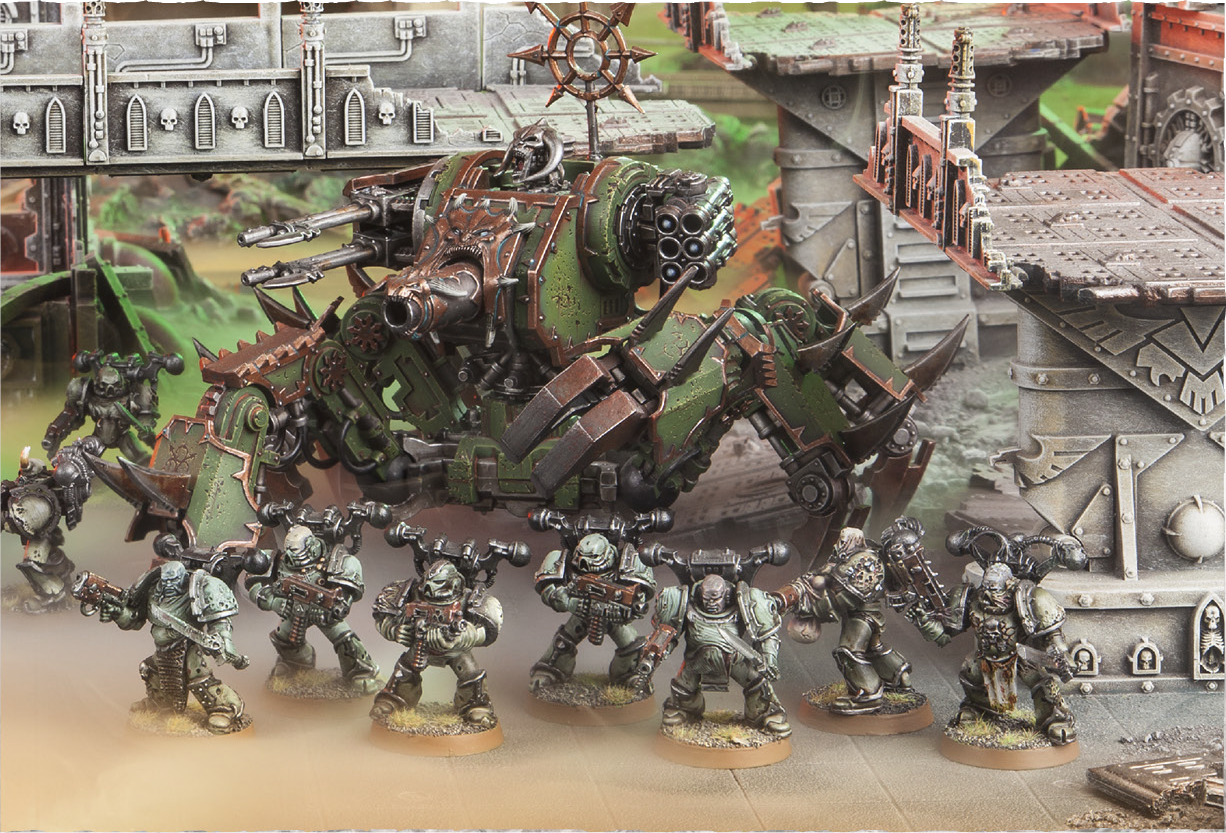
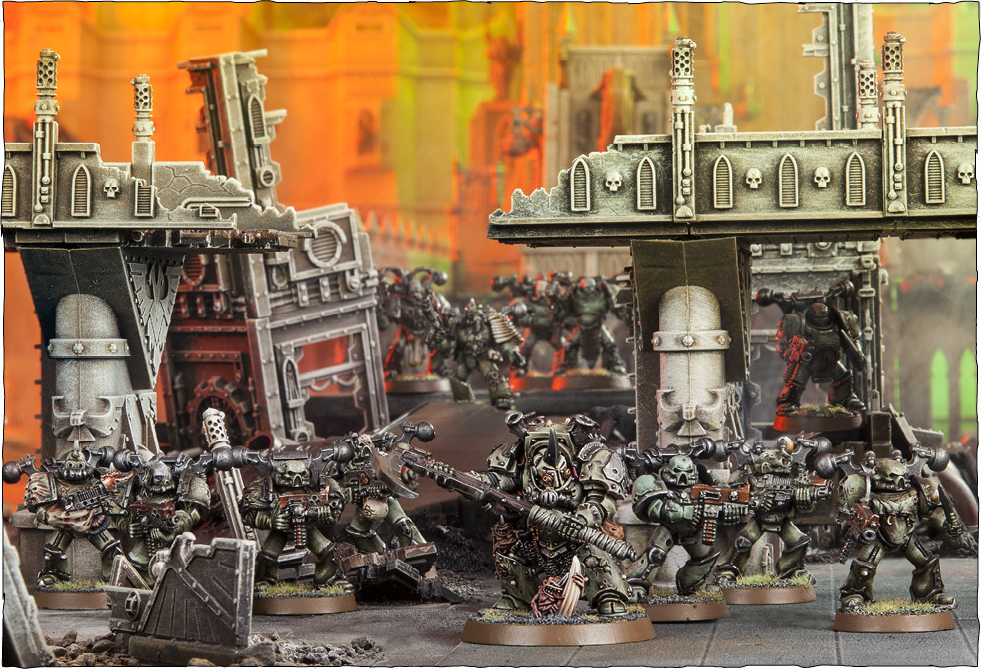
Warbands of Plague Marines are often found organised in squads of seven, banded together into groups of seven squads. An echo of the Death Guard Legion's organisational model at its height, seven is also the sacred number of the Legion's patron power, and they believe that by forming themselves in multiples of that number they carry the favour of the Chaos God Nurgle. Whether this organisation draws the attention and sorcerous blessing of the Plague God or not, the manner in which the Plague Marines carry themselves to war still reflects the hand of Mortarion, the grim Primarch who forged them, shaped them, then led them to their damnation. The Plague Marines revel in the contamination of Imperial worlds, sowing pestilence and contagion wherever they go and inflicting cruel and agonising deaths on a planetary scale.
This is a Death Guard Detachment (see pg 116).
Enervating Pestilential Aura: Enemy models within 7" of any Plague Colony units at the start of the Fight sub-phase must reduce their Initiative and Weapon Skill by 1 for the duration of the phase. If this Formation includes the maximum number of units at the start of the battle, then enemy models within 7" of any Plague Colony unit at the start of the Fight sub-phase must also reduce their Toughness by 1 for the duration of the phase.
An ancient device infused with the atrophying power of the Warp, the Hand of Darkness decays all and everything that its wielder touches. Flesh sloughs from bones and armour is reduced to little more than pools of liquid slag. It was with this fabled artefact that Abaddon finally gained access to the inner workings of the Blackstone Fortresses, before later surrendering it to the Daemon Primarch Mortarion to secure the allegiance of the Death Guard for his Thirteenth Black Crusade.
When making his close combat attacks, the bearer of the Hand of Darkness can instead choose to make a single special attack that uses the profile below:
| Range | S | AP | Type |
|---|---|---|---|
| - | x2 | 1 | Melee, Armourbane, Fleshbane, Instant Death |
On these pages, you will find special rules unique to armies from the Death Guard that reflect their tactics on the battlefield. You will also find Warlord Traits, Chaos Artefacts and Tactical Objectives that you can use when fielding your Death Guard army in games of Warhammer 40,000, and an exclusive Detachment - the Vectorium.
Any Detachment with the Chaos Space Marines Faction can be from one of the nine Traitor Legions. A Death Guard Detachment retains the Chaos Space Marines Faction and is treated in all ways as a Chaos Space Marines Detachment, with the following modifications:
All units in a Death Guard Detachment or Formation gain the following special rules:
Units that have the Veterans of the Long War special rule have the Fearless and Feel No Pain special rules, but reduce their Initiative characteristic by 1. Typhus and units of Plague Marines are unaffected.
Units that have the Veterans of the Long War special rule have the Relentless special rule.
Units of Plague Marines are Troops choices instead of Elites choices.
Units in a Death Guard Detachment or Formation that can normally take Chaos Artefacts in Codex: Chaos Space Marines can choose to take items from the Chaos Artefacts of the Death Guard list (see opposite) at the points cost shown instead.
When generating his Warlord Traits, a Warlord from a Death Guard Detachment or Formation may choose to roll on the table to the right instead of those found in Warhammer 40,000: The Rules or Codex: Chaos Space Marines.
| D6 | Warlord Trait |
|---|---|
| 1 | Insensate to Pain: So vast and bloated has this Warlord become that he is all but immune to the pain of injury. Add 1 to your Warlord's Feel No Pain rolls. |
| 2 | Tainted Regeneration: So blessed is this Warlord with Nurgle's foetid restorative powers that his body heals itself as fast as his enemies can harm him. Your Warlord has the It Will Not Die special rule. |
| 3 | Lord of Contagion: Saturated as he is with Nurgle's contagious blessings, merely to stand before this Warlord and his closest warriors is to be assailed by an oppressive aura of plague. Your Warlord and all friendly units from a Death Guard Formation or Detachment that are within 7" of your Warlord at the start of the Fight sub-phase are infected with a contagious plague until the end of the phase. All enemy units that are locked in combat with any units infected in this manner suffer D6 Strength 1 AP 4 hits with the Poisoned (4+) special rule (distributed randomly) at the Initiative 10 step. |
| 4 | Hulking Physique: This Warlord's body has become swollen with Nurgle's divine blessings, and stands all but inviolate as a veritable behemoth of rancid flesh. Add 1 to your Warlord's Wounds characteristic. |
| 5 | Rotten Constitution: Nurgle's favour takes many forms, and this Warlord's flesh has become so rot-infested that vast chunks of it can be torn free without risk of lasting harm. Your Warlord has the Eternal Warrior special rule. |
| 6 | Arch-contaminator: Such are this Warlord's virulent emanations that his very presence is enough to make even the most lethal toxins and venoms deadlier still. The effect of the Poisoned special rule on any weapons wielded by your Warlord and any models in his unit is improved by 1, to a maximum of 2+. For example, if your Warlord joined a unit of Plague Marines, their plague knives would have the Poisoned (3+) special rule instead of Poisoned (4+). |
Nurgle's putrescent blessing hangs heavy in the air about the Death Guard's most sacred relics, and proximity alone is often enough to infect those who breathe deep of their noxious foulness. Only one of each of the following items may be chosen per army, and only one may be chosen per model.
Appearing as a particularly large plague knife, more like a machete than the traditional side weapon of the Death Guard Legion, the Puscleaver bears the infamous Gurgling Doom contagion. One struck by the blade has not only to contend with part of their anatomy being hacked away, for its edge remains punishingly sharp, but also a wound so infected balloons into a swollen mess in seconds. The afflicted individual keels over a moment later, gurgling phlegm as he finally realises the glory of Nurgle's generosity.
Replaces one of the bearer's Melee weapons.
| Range | S | AP | Type |
|---|---|---|---|
| - | User | - | Melee, Poisoned (2+) |
This oversized death's head was once the skull of the Chaos Lord Glothila, whose dying wish was to become a weapon of purest evil.
Once per game, instead of firing his weapon, the bearer of the Plague Skull of Glothila can choose to make a shooting attack that uses the profile below:
| Range | S | AP | Type |
|---|---|---|---|
| 8" | 1 | - | Assault 1, Large Blast, One Use Only, Poisoned (2+) |
This rune-engraved artefact is long and pitted, mouldering with a visible miasma of plague and entropy. Every one of its odd dents and holes harbours a deadly strain of contagion, one of Nurgle's old favourites, tried and proven. Collectively, the grotesque diseases that riddle the Pandemic Staff have seen trillions of lives ebb away to nothing, reduced to little more than fodder for the Grandfather's Garden. When waved expansively, the staff can conjure forth a tide of hypertoxic fluids that could bring low even a rampaging pestigor.
Replaces one of the bearer's Melee weapons. The bearer can also use the Pandemic Staff in the Shooting phase instead of firing another weapon.
| Range | S | AP | Type | |
|---|---|---|---|---|
| Ranged | Template | 1 | 5 | Assault 1, Poisoned (2+) |
| Melee | - | +2 | 4 | Melee, Concussive, Poisoned (2+) |
The clangour of this giant bell is painful to the ear, almost intrusive as its foul sounds push their sickening notes into the minds of those nearby. Each toll registers as a dull clank on the data-harvest of recording devices such as vid-thief skulls, but to hear it in person is quite another matter. Bravery is undone and certainty ebbed away as the shambling horde of the Death Guard closes in, rendered as looming behemoths by the peals of the deathly knell.
All friendly Death Guard units within 14" of the bearer at the start of the Fight sub-phase have the Fear special rule for the duration of the phase. In addition, enemy units taking a Fear test against an affected unit must do so on 3D6 instead of 2D6.
Daemon insects spill from the tubular, chimney-like structures of the Poxwalker Hive. The incessant droning chatter of these tiny creatures acts as an infection in its own right, and those who willingly listen to it are at grave risk of contracting the poxwalker's curse. Should they succumb, they will devolve into shambling, mutant monstrosities, murmuring and babbling in the same flyblown tongue as the hive itself.
At the start of each of your turns, pick a friendly unit of Chaos Cultists within 7" to infect with the poxwalker virus. For the rest of the game, that unit of Chaos Cultists cannot Run or make shooting attacks, but they gain the Fearless and Feel No Pain special rules. In addition, at the start of each of your following turns, return D3 slain models to every friendly unit of infected Chaos Cultists that are within 7" of the bearer. Any models returned in this manner that cannot be placed within unit coherency are lost.
The hooked blade Plaguebringer once bore the souls of a trio of Beasts of Nurgle. Once the sword sprayed the virulent, infected spittle of these overexcitable Daemons with every swing. However, those entities were trapped so long in the rusted artefact's confines that their lethally potent enthusiasm has drained away, replaced with something even worse. After a long period of sulking, the blade's inhabitants became something else entirely; it now contains the malignant souls of three Rot Flies that take every chance to inflict a terrible wasting disease on those around them.
Replaces one of the bearer's Melee weapons.
| Range | S | AP | Type |
|---|---|---|---|
| - | User | 3 | Melee, Daemon Weapon*, Poisoned (4+) |
*See Codex: Chaos Space Marines.
Vectoriums are used exclusively by the forces of the Death Guard. The rules below will allow you to organise the models in your Chaos Space Marines collection of miniatures to represent one of these Detachments in your games of Warhammer 40,000.
When choosing an army to play a game of Warhammer 40,000, there are two main ways of organising your collection. These are the Unbound method, which means taking whichever units you like, and the Battle-forged method, which is more rigid but has extra benefits. Both are described fully in Warhammer 40,000: The Rules.
If you are using the Unbound method, simply use the datasheets that correspond to the models in your collection. If you are using the Battle-forged method, you will instead need to organise the models in your collection into Detachments. This is a fun process in its own right. The most common of these are the Combined Arms and Allied Detachments.
A Vectorium is a special type of Detachment that can be included in any Battle-forged army. Unlike the Detachments shown in Warhammer 40,000: The Rules, it has a Force Organisation Chart whose slots are a combination of specific Formations and Army List Entries instead of Battlefield Roles. However, it still has compulsory and optional elements, as well as Restrictions and Command Benefits, just like any other Detachment.
Although units cannot normally belong to more than one Detachment, units from a Formation that is part of a Vectorium are an exception. They count as part of both their Formation and the Detachment, and have all associated Command Benefits and special rules. If your Warlord is part of a Formation or an Army List Entry that makes up part of a Vectorium, the entire Vectorium is your Primary Detachment.
The Vectorium allows you to represent the typical structure of a Death Guard army on the battlefield. Whether you wish to bring death and destruction with the full might of a Chaos invasion force, or field an elite warband tasked with some dark purpose, the choices below offer a great way to pick your army.
For example, Erik's Chaos Space Marines collection consists of Typhus, a Chaos Lord, a Dark Apostle, a Daemon Prince, four units of Plague Marines, two units each of Chaos Space Marines, Chaos Terminators and Chaos Cultists, one unit each of Raptors and Chosen, a Helbrute, two Heldrakes, a Defiler and two Maulerfiends.
If Erik wishes to organise his collection using the Battle-forged method - as described in Warhammer 40,000: The Rules - all of his units need to be part of a Detachment or a Formation. Erik achieves this by choosing one Vectorium and one Combined Arms Detachment from Warhammer 40,000: The Rules.
The Vectorium in Erik's army consists of two Core choices - a Plague Colony (Typhus and the Plague Marines) and a Chaos Warband (his Chaos Lord, Chosen, Chaos Terminators, Chaos Space Marines, Raptors and Helbrute) - and a Heldrake Terror Pack (his pair of Heldrakes) as an Auxiliary choice.
Erik's Dark Apostle, Daemon Prince, Chaos Cultists, two Maulerfiends and Defiler form a Combined Arms Detachment. As all of his units belong to a Detachment, the army is Battle-forged. Erik chooses Typhus to be his Warlord - his Vectorium is therefore his Primary Detachment. The units that are part of it have the Plague Lord, Disgustingly Resilient and Cloud of Flies Command Benefits, whilst those that are part of the Combined Arms Detachment have the Objective Secured Command Benefit.
This Detachment must include at least one Core choice and one Auxiliary choice. It may include up to four Command choices and any number of additional Core or Auxiliary choices, in any combination. Only the datasheets listed here can be included in this Detachment and all units must have the Chaos Space Marines Faction.
Plague Lord: If this Detachment is your Primary Detachment, you can re-roll the result when rolling on the Death Guard Warlord Traits table (pg 116).
Disgustingly Resilient: Units from this Detachment can re-roll Feel No Pain rolls of 1.
Cloud of Flies: If an enemy unit targets a unit from this Detachment that is 18" or more away, the target unit has the Stealth special rule while that attack is resolved.
| Core | Chaos Warband | (pg 46) |
| Core | Plague Colony | (pg 70) |
| Command | Lord of the Legion | 1 of the following:
|
| Auxiliary | The Lost and the Damned | (pg 48) |
| Auxiliary | Helforged Warpack | (pg 49) |
| Auxiliary | Heldrake Terror Pack | (pg 50) |
| Auxiliary | Cult of Destruction | (pg 51) |
| Auxiliary | Fist of the Gods | (pg 52) |
| Auxiliary | Raptor Talon | (pg 53) |
| Auxiliary | Terminator Annihilation Force | (pg 54) |
| Auxiliary | Favoured of Chaos | (pg 55) |
| Auxiliary | Spawn | 1-3 units of Chaos Spawn |
Command 0-4, Auxiliary 1+, Core 1+
Presented below are six Tactical Objectives to use in your games of Warhammer 40,000, which are exclusive to Death Guard players and reflect the foetid and utterly relentless nature of the Death Guard in battle.
If your Warlord is from a Death Guard Detachment or Formation, you may replace the Capture & Control Tactical Objectives (numbers 11-16) described in Warhammer 40,000: The Rules with the Tactical Objectives on this page.
If a Warhammer 40,000 mission has the Tactical Objectives special rule, players use the normal rules for using Tactical Objectives with the following exception: when a Death Guard player using these Tactical Objectives generates a Capture & Control objective (numbers 11, 12, 13, 14, 15 or 16), they instead generate the corresponding Death Guard Tactical Objective, as shown in the table. Other Tactical Objectives (numbers 21-66) are generated normally.
| D66 | Result |
|---|---|
| 11 | Death March |
| 12 | Pain is for the Weak |
| 13 | Nurgle's Gift |
| 14 | Spread Plague and Contagion |
| 15 | Symbol of the Fly-Lord |
| 16 | Death Begets Life |
The slow, inexorable advance of the Death Guard has been the death knell of worlds beyond count.
Score 1 Victory Point at the end of your turn if at least 3 of your units are within your opponent's table half.
Nurgle despises physical frailty and blesses his followers with bloated bodies filled with decay that they may forever forgo its touch.
This Tactical Objective is achieved if you make at least 7 Feel No Pain rolls in any single phase. You immediately score 1 Victory Point.
Nurgle enjoys little more than watching his followers spread his diseases upon the mortal races.
Score 1 Victory Point at the end of your turn if at least one enemy unit was completely destroyed by a weapon or psychic power that had the Poisoned special rule during that turn.
The lords of the Death Guard have survived for countless centuries, enduring to spread disease to every world they invade.
When this Tactical Objective is generated, nominate one of your Death Guard characters. Score 1 Victory Point at the end of the game if this character is still alive and on the table.
The symbolism of the three-eyed fly holds great meaning to the worshippers of the Plague God.
Score D3 Victory Points at the end of your turn if you control exactly three Objective Markers - no more, no less.
To the followers of Nurgle, the endless cycle of sowing death that new life may bloom is nothing less than a sacred act.
Score 1 Victory Point at the end of your turn if at least 7 enemy models were slain during your turn. If at least 14 enemy models were slain during your turn, score D3 Victory Points instead, and score D3+3 Victory Points if at least 21 enemy models were slain during your turn.
Psykers that are blessed by Grandfather Nurgle can channel the Plague God's corrupting powers to debilitate or infect their victims with rancid visitations. Even those fortunate enough to survive the touch of such unwholesome energies will forever be tormented by their legacy.
Gurgling praise to Father Nurgle, the psyker selflessly exudes a disgusting wave of soul-pox. All those nearby are covered in a layer of toxic goo so foul it can kill in seconds.
Nurgle's Rot is a nova power with the profile below. Note that Daemons of Nurgle and models with the Mark of Nurgle are unaffected by Nurgle's Rot - in fact, they find it rather refreshing!
| Range | S | AP | Type |
|---|---|---|---|
| 6" | 2 | 5 | Assault D6+1 |
The psyker invokes the generosity of his patron, infesting his foe's weaponry with viral decay.
Weapon Virus is a malediction that targets a single enemy unit within 24". All of the target unit's ranged weapons have the Gets Hot special rule whilst the power is in effect.
Nurgle's bountiful energies surge through the target and the deep wounds that score their flanks begin to secrete foul fluids that thicken and harden upon contact with the air. By the time the psyker's power has run its course, the target's injuries are nowhere to be seen, hidden beneath the swollen folds of new fleshy growth.
Fleshy Abundance is a blessing that targets a single friendly model within 14" of the Psyker. The affected model immediately regains D3 Wounds lost earlier in the battle.
As the psyker draws forth more of Grandfather Nurgle's power from the Warp, the blades of his allies begin to rust and secrete foul, pus-like fluids, the stench alone of which bears the promise of disease.
Blades of Putrefaction is a blessing with a range of 14". The Melee weapons of all models in the target unit have the Poisoned (4+) special rule whilst this power is in effect. Any models that already had the Poisoned special rule on their Melee weapons or attacks instead have the Poisoned (2+) special rule whilst this power is in effect.
The psyker gathers clouds of contagion and Rot Flies about his enemies, granting them Father Nurgle's blessing.
Gift of Contagion is a malediction that affects a single enemy unit within 48". Roll on the table below to see what effect it has on every model in the unit whilst the power is in effect. The effects of multiple Gifts of Contagion are cumulative.
| D3 | Disease Granted | 1 | Flyblown Palsy: -1 Attack and the Shrouded special rule. | 2 | Muscular Atrophy: -1 Strength and may not Run. | 3 | Liquefying Ague: -1 Strength and -1 Toughness. |
|---|
The psyker belches forth a wind of plague that blows through his foes.
Plague Wind is a witchfire power with the profile below. It has no effect on vehicles.
| Range | S | AP | Type |
|---|---|---|---|
| 12" | 1 | 2 | Assault 1, Large Blast, Poisoned (4+) |
The victims of this curse find themselves weakened and drained by its enervating touch, yet those that bear Nurgle's favour are instead granted new strength by the rancourous energies coursing through their bloated bodies.
Curse of the Leper is a blessing if it targets a friendly unit, or a malediction if it targets an enemy unit; in either case, it must target a single unit within 21" of the Psyker. If Curse of the Leper is used to target a friendly unit, all models in that unit add 1 to their Strength and Toughness characteristics whilst this power is in effect; if used to target an enemy unit, all models in that unit must reduce their Strength and Toughness characteristic by 1 whilst this power is in effect.
